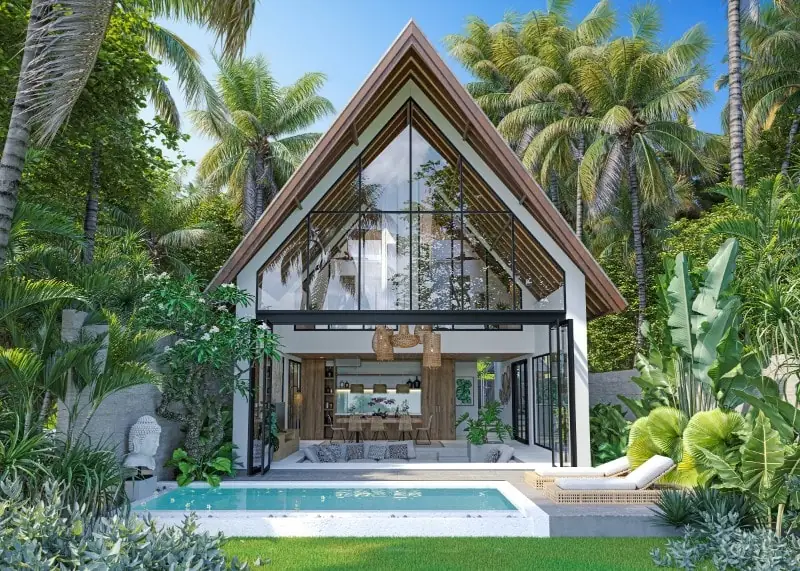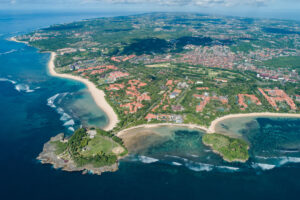Bali Property Market 2025: From Hype to Maturity
The Bali luxury real estate scene is evolving fast , and Munggu, a tranquil village just west of Canggu, is quickly becoming the island’s next premium hotspot. With international developers introducing Scandinavian-inspired residences and investors seeking lifestyle-driven returns, Munggu represents the new face of refined living in Bali. This BaliWide Exclusive explores the forces behind Munggu’s rise, from the hybrid lifestyle boom and cultural integration to sustainable luxury design. For investors looking to be part of Bali’s next success story, Munggu offers rare balance: authenticity, profitability, and timeless appeal.
The Bali luxury property market is surging once again with a fresh wave of investment transforming the island’s northern Badung region. Once considered a quiet rural area, Munggu is now emerging as a serious contender to Canggu’s dominance in Bali’s premium real estate scene. With international developers introducing Scandinavian-inspired residences and investors seeking a more balanced lifestyle between nature and modernity, the question is no longer if Munggu will rise, but how soon it will overtake its trendier neighbor.

In this article, BaliWide explores the new face of Bali’s high-end property landscape , the evolution of luxury living, the growing appeal of Munggu, and how hybrid lifestyles and local cultural capital are redefining the next phase of investment on the island.
The Post-Pandemic Recalibration
After the global travel recovery, Bali’s real estate market rebounded sharply. However, what began as a rapid post-pandemic boom has now evolved into a more mature and discerning market. Investors today are not merely chasing hype , they are pursuing longevity, yield, and design intelligence.
According to industry insights from SAS Bali (2025 trends report), Bali’s property market is transitioning from speculative frenzy to value-driven investments. The focus has shifted toward efficiency, liquidity, and sustainable design. The number of off-plan developments has risen to nearly 37% of total listings, with buyers seeking early-stage opportunities backed by credible developers.
Meanwhile, data from Investland Bali suggests that luxury villas in Bali’s main tourism areas still offer gross rental yields of 7 – 15%, depending on management efficiency and occupancy. Even as nightly rates dropped by roughly 16% in Q1 2025, overall occupancy increased by 2.3%, showing that long-term demand remains robust , especially for properties that blend aesthetics with functionality.
Compact Luxury and Smart Design
One of the clearest trends emerging across Bali is the rise of compact luxury properties. Developers are now focusing on villas and apartments that are smaller in size but smarter in function , featuring optimized layouts, integrated smart systems, and easy maintenance.
Buyers prefer compact homes for two reasons: they are easier to manage and offer better liquidity. A smaller yet highly functional luxury villa with strong architectural identity is now more desirable than sprawling, inefficient mansions.
Developers, too, are becoming more cautious. Rather than flooding the market with projects, many prefer to launch fewer but more refined developments , ensuring sustainable absorption rates and investor confidence.
The New Luxury: Tech, Sustainability, and Experience
In 2025, luxury in Bali means more than just marble floors and infinity pools. It’s about experience, sustainability, and cultural authenticity.
Trends shaping this segment include:
- Smart villas and automation: Properties are increasingly integrated with IoT systems, AI-driven climate control, and remote management capabilities.
- Eco-luxury living: Developers now incorporate solar panels, rainwater harvesting, and locally sourced materials to appeal to environmentally conscious buyers.
- Experiential real estate: Many premium projects partner with hospitality brands to provide hotel-style management and curated lifestyle services.
- Cultural aesthetics: Modern villas now blend Balinese craftsmanship with global design styles — from Scandinavian minimalism to Japanese zen — creating homes that feel both sophisticated and soulful.
Market Challenges and Risk Awareness
While the Bali market remains attractive, investors must stay alert to key risks:
| Challenge | Impact |
|---|---|
| Oversupply in mid-tier markets | Increased competition and rental price compression |
| Foreign ownership limitations | Complex leasehold or PT PMA structures required |
| Global tourism fluctuations | High dependency on travel and digital nomad markets |
| Project delivery delays | Potential risk in off-plan investments |
Munggu: Bali’s Hidden Gem on the Rise
A Village Turned Vision
Once overshadowed by its bustling neighbor, Munggu is now becoming a magnet for discerning investors. Located just west of Canggu, Munggu still retains its serene village charm, lush rice fields, ocean breezes, and the sound of temple gamelan, but with growing connectivity and developer interest.
The area’s transformation began with small boutique villas, yoga retreats, and eco-conscious cafés, catering to wellness-focused travelers and digital nomads seeking tranquility. Today, high-end developers are reimagining Munggu as the next frontier of refined tropical living.
A prime example is LEVÍRO Residences, developed by Core Concept Living, set to become the first Scandinavian-style residential project in Bali. Designed for international buyers who appreciate minimalist elegance, LEVÍRO combines Nordic simplicity, Japanese precision, and Balinese warmth , a true architectural symphony.
The project, spanning 9,060 square meters, will feature exclusive villas with 3 to 6 bedrooms, each crafted with natural materials, open layouts, and handcrafted interiors. Construction begins in early 2026, with handover planned by late 2027.
Why Munggu May Overtake Canggu
Several key factors explain why investors are shifting focus from Canggu to Munggu:
- Space and serenity: Munggu offers larger plots and open landscapes — a rare luxury as Canggu becomes increasingly dense.
- Lower entry cost: Land acquisition and development costs remain 20–30% lower than Canggu’s prime zones.
- Future upside: Investors love “the next big thing.” Munggu offers early-entry opportunities before prices peak.
- Lifestyle branding potential: Developers can position Munggu as “Bali’s future — without the chaos.”
- Cultural authenticity: Unlike over-commercialized areas, Munggu still exudes authentic Balinese life, which appeals strongly to global buyers seeking meaning, not just status.
Infrastructure and Investor Strategy
While Munggu’s infrastructure is improving, it still lags behind Canggu in some aspects. Smart investors and developers are addressing this by integrating infrastructure solutions within their projects, such as private road access, independent water systems, and on-site community amenities.
| Risk | Mitigation Strategy |
|---|---|
| Limited public infrastructure | Develop self-sufficient utilities and access roads |
| Lack of lifestyle facilities | Partner with co-working, spa, and café operators |
| Perceived remoteness | Market it as “accessible serenity” with proximity benefits |
| Zoning uncertainty | Conduct in-depth due diligence and engage reputable legal advisors |
The Hybrid Lifestyle Factor: Work + Wellness + Wealth
The New Investor-Resident Hybrid
One of the most influential post-pandemic shifts driving Bali’s premium market is the rise of the hybrid lifestyle investor , individuals who merge work, wellness, and travel into a seamless routine.
These digital professionals, entrepreneurs, and families are no longer seasonal visitors. They live and work in Bali for months or even years, seeking homes that support remote work, leisure, and community living.
The growing availability of high-speed internet (including Starlink connectivity) and the government’s Digital Nomad Visa have further strengthened this demographic. This group is now a major driver of property demand, particularly for villas with smart layouts and flexible management options.
Design Priorities for the Hybrid Lifestyle
Hybrid lifestyle buyers prioritize functionality and inspiration. Key property features now include:
- Dedicated workspaces or convertible study rooms
- Reliable high-speed internet infrastructure
- Quiet, green environments with natural light
- Community amenities such as cafés, gyms, yoga studios, and co-working spaces
- On-demand management services and flexible rental programs
Developers who adapt to these needs gain a significant edge. The combination of long-term livability + short-term flexibility ensures sustained occupancy, reducing the impact of tourism seasonality.
Long-Term Stability in Hybrid Markets
Unlike purely tourism-driven properties, hybrid-oriented villas offer more consistent income. These homes attract tenants year-round , not only holidaymakers but also families, consultants, and remote executives seeking stable environments.
In essence, hybrid living turns Bali from a seasonal destination into a sustainable living hub , and Munggu, with its balance of tranquility and connectivity, is perfectly positioned to capture this new wave.
Smart Investment Strategies for Bali’s Evolving Market
Due Diligence is Everything
Before investing in Bali’s premium sector, especially in emerging areas like Munggu, investors must ensure every layer of legality, structure, and risk is well-analyzed.
Key Steps for Smart Investment:
- Market Micro-Study: Understand the neighborhood dynamics, accessibility, and competing developments.
- Legal Compliance: For foreign buyers, explore options like Leasehold, Hak Pakai, or PT PMA structures. Ensure extensions are clearly stated.
- Financial Projection: Calculate net yields, taxes, maintenance, and management costs.
- Design Versatility: Invest in adaptable layouts with natural ventilation, daylight optimization, and multi-use rooms.
- Professional Management: Choose credible operators to handle rentals and maintenance.
- Storytelling & Branding: Use cultural narratives and design authenticity to differentiate.
- Flexible Leasing Models: Combine short-term and long-term rentals to balance cash flow.
Emerging Investment Models
Modern investors are now exploring creative ownership models, such as:
- Fractional ownership: Shared investment in a single villa to lower capital risk.
- Branded residences: Luxury homes managed by hotel operators under global lifestyle brands.
- Hybrid co-living spaces: Combining private units with shared facilities for community living.
- Buy-to-rent strategies: Focused on yield optimization with professional property management.
Comparing Hotspots: Where Munggu Stands
| Area | Strengths | Challenges | Upside Potential |
|---|---|---|---|
| Canggu / Berawa | Established lifestyle hub | Saturation, traffic, high land cost | Stable but limited growth |
| Seminyak | Iconic luxury and nightlife | Highly tourist-dependent | Strong but mature market |
| Uluwatu / Pecatu | Ocean views, privacy | Accessibility, topography | High-end long-term value |
| Pererenan / Nyanyi / Tumbak Bayuh | Semi-rural charm | Limited infrastructure | Strong mid-term growth |
| Munggu | Balance of peace and access | Needs more infrastructure | The next “big thing” potential |
Building the Munggu Brand: From Hidden Gem to Elite Destination
Crafting the Identity
To position Munggu as Bali’s next premium lifestyle district, branding and communication play a vital role. Developers and marketers must shape the area’s story with authenticity and aspiration.
Key Branding Themes:
- “Accessible exclusivity” , luxury without chaos
- “Where nature meets design” , serenity wrapped in sophistication
- “Cultural continuity” , respecting Balinese heritage while introducing global refinement
High-quality storytelling, combined with professional visuals, drone footage, immersive 3D renders, and artistic branding , can elevate Munggu’s reputation in global investor circles.
Community-Driven Growth
Unlike the purely commercial expansion seen in parts of Canggu, Munggu’s rise should emphasize community and sustainability. Projects that integrate local collaboration, environmental care, and cultural respect will attract investors who value both profit and purpose.
Developers can build partnerships with local artists, temples, and small businesses to maintain the village’s soul while elevating its economic potential. This social capital becomes part of the property’s intrinsic value.
The Power of Local Social Capital
Beyond ROI: Investing in Meaning
Property investment in Bali is no longer just about numbers. It’s about connection, to people, place, and culture. Munggu’s biggest asset is not only its land but its community fabric.
Developers who engage with locals, employ Balinese artisans, and preserve natural landscapes don’t just create beautiful homes — they create stories. These narratives resonate deeply with global buyers who crave authenticity and emotional resonance.
Examples of Culturally Integrated Design
- Use of locally sourced stone and wood, supporting village economies.
- Incorporation of Balinese temple-style courtyards within modern villas.
- Partnerships with Balinese architects and craftsmen for hybrid aesthetics.
- CSR initiatives that enhance infrastructure, education, and conservation.
In the luxury market, authenticity is the new exclusivity. A villa that embodies both refinement and respect carries unmatched long-term value.
Munggu as the New Face of Bali’s Premium Living
Bali’s property narrative is entering a new chapter. The race is no longer about who builds first, but who builds smarter, deeper, and more beautifully.
Canggu may have written the last decade’s story of transformation, but Munggu is poised to write the next a story of balanced growth, architectural evolution, and hybrid lifestyle harmony.
For investors and developers who can see beyond the surface, Munggu offers a rare opportunity: to create spaces that not only generate returns but also nurture community and culture.
Because in Bali, the true measure of success isn’t just ROI , it’s the legacy you leave behind.





